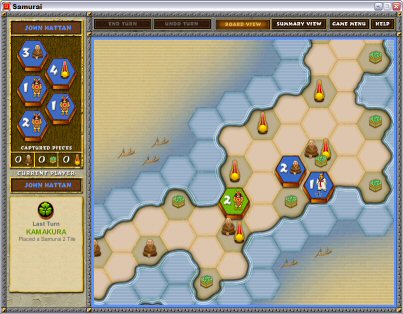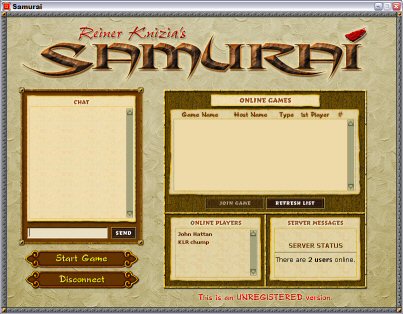All four developers were available for the interview, David Adams, the catalyst of the group, Walker Hale IV, the resident nerdy guy (I mean this as a high compliment, really), Charles Grant, the artiste, and Darcy Brown, the quiet guy. When I sat down, I could tell that these developers were really excited and proud to be finalists in the IGF. "That deadline was not one we wanted to miss," said Charles Grant about the September 1, 2002 IGF Competition submittal date.
Klear Games is essentially a bootstrap company. David Adams told me that he attended the 2001 Game Developers Conference in order to try to get a job in the game industry. "Basically no one was interested in talking to me since I didn't have experience writing games," he said. So, if someone isn't willing to hire you, start your own company. That's exactly what David did. He knew programmers and artists from other jobs who had the talent and the ambition to risk it all and do what they really wanted to do - program games.
Klear Games is self-funded and is located in a studio above David Adams' garage. They initially started programming on a full-time basis, but as money became scarcer, they worked part-time and paid the bills with contract work. Klear play-tested various different board games but settled on Reiner Knizia's board game Samurai. Samurai is a popular game, but it is an older title and not a current "hot" one. "But it's a lot of fun to play," Charles Grant said. "My girlfriend is not a gamer and she really enjoys playing this game. I still haven't beaten her yet." Klear Games contacted Rio Grande Games which is the American distributor for Samurai's German board game publisher, Hans Im Gl?ck (HIG). Rio Grande and HIG has worked with other developers with the aim of porting their more popular titles, but the results of the other licenses have been mixed at best. Klear Games had their work cut out for them. The contract had hard deadlines to meet. "HIG had some industry horror stories regarding other developers, and they wanted to make sure the game would get developed," stated David Adams. Reiner Knizia did not see Klear Games version of Samurai until the product was one-year into development. "Reiner has seen the game and likes what we've done with it," said Charles Grant.
The Klear Games design team all agree that the fun part of developing the product is seeing it play for the first time. The background of the programmers lies mainly in the multimedia and web development job markets. Samurai is the first commercial game they have worked on. The hard part of being a startup game development company according to David Adams is trying to beat the learning curve. The learning curve translates into not knowing how long something would actually take to program. "We'd think something would only take two weeks, and six weeks later we'd have it done," said David.
David's view of development is "Bigger is a function of budget. Better is a function of creativity." Since Klear Games is a small design team, they have to program smaller scale projects. They intend to stay with the board game genre and are talking to several publishers for future projects.
Samurai was designed largely with Macromedia Director, which gave the product its cross platform capabilities. The UI and networking were done using Lingo (Director's internal scripting language), and the AI and game logic were done in C++ using Metrowerks CodeWarrior. This was a product designed from the ground-up to be cross-platform. Director wasn't chosen lightly -they looked at the cross-platform frameworks at the time and saw that Director was by far the most mature of the bunch, being around for over a decade now. According to Walker, there are less than 100 lines of platform-dependent code in the entire game. It's available for both the Mac and the PC.
[size="3"]Review of the game
Let me be up front about how I like to play games. I like the mechanics of game play; the environment in which it is played has always come secondary to me. It is my opinion that if the game mechanics are good, then it really doesn't matter where the game takes place. That is why I am really enamored with Samurai. Its game mechanics are great and the game design does not hide game flaws within the game environment. The environment of Klear Games' version of Samurai absolutely complements the strong game mechanics established by the German board game designer, Reiner Knizia.

[size="2"]Samurai's opening screen reveals a clean, classy look
Samurai is a 2-D product and is designed from the ground-up with an isometric look. When the game first begins, you see an island with different pieces scattered around. There are three different types of pieces: the Buddha, the helmet, and rice. The pieces are located in cities (a hex with two or three pieces on it) and villages (a hex with only one piece) and are captured by placing hexagonal tiles adjacent to the pieces. The board and the card tiles are hexagonal. Once hexagonal tiles surround the piece, the value of the tiles is calculated and the pieces are awarded to the strongest player, or are neutralized if the score is tied. The idea is to capture as many of the pieces as possible - but you have to be careful. You should not try to capture only one type of piece. The object of the game is to influence as many of the castes as you can. If you dominate in one caste and ignore the other two, you will most likely lose the game.
You have 9 tiles you can only play once per turn. There are others with a little character that looks like an upside-down telephone pole, which can be used anytime during their turn. Each turn a player has a hand made up of five tiles randomly selected from all their tiles. The registered version allows a player to choose their first five tiles, which can give a player a distinct advantage if they properly plan their turns.
The board has a total of four islands. For the novice game, only the large island is used. For a three-player game, three islands are open and I expect a four-person game will have all four islands available for play. The locations of the cities and towns do not change from game to game. I am reviewing the un-registered version of Samurai and it looks as though you can change up the location of the pieces on the board with the registered version.

[size="2"]Samurai's graphics are very well-done, despite the game-board being a simple hex-based representation of Japan
Samurai cannot be found on your local software stores for the time being. The distribution is limited to direct sales through the Klear Games website (www.klear.com) Initially I could not find the link to the demo, but that's my own fault because it's very prominent on their website. The file size for the demo is 12.9 M and was very quick to download with a DSL connection. The installation was quick and straightforward.
As with any nontrivial board game, a player will not be able to figure out how to play the game just by looking at it. The Klear Games developers have pulled together an excellent self-running tutorial, which makes game play clear and quick to understand. For some folks who just want to quickly read the instructions and play the game, the idea of wading through a tutorial can be a little annoying. I was a bit leery about going through the tutorials at first because I really did not want to spend a lot of time trying to learn how to play the game - I just wanted to play it. For the sake of review, I went through the tutorial and was pleasantly surprised. There are four lessons that step you through very nicely and quickly. The animation of the tutorials combined with the instructions made it very easy for me to pick up how to play the game.

[size="2"]The tutorial is simple and tells you what you need to get going
The game can be played against the computer or can be played over the Internet or a local network. For the first game, I played a single player game against the computer at the novice level. The novice game is a two-player game with one human player and one computer player. The intermediate single-player game is played with one human player and two computer players.
I also played a quick Internet game against my husband. He had the distinct disadvantage in that he had not yet gone through the tutorial and was a little frustrated because he didn't know what he was doing. Playing a game through the Klear Games server site was straightforward, and we were able to start up a game very quickly. My only complaint with the network version is with the chat box. The area to type your message is small and if you type beyond it, you can't see what you're typing. This is a small gripe but valid because chat is really important when playing a live player over the Internet.

[size="2"]Here's the chat lobby you'll see when you connect to Klear.com
The music of Samurai is really very beautiful and soothing. I wouldn't mind getting a CD of it for my own listening pleasure. I consider the soundtrack to be modern-day smooth jazz music with an Asian influence. Mark Hunton wrote the original music and it is definitely is a great feature to this product. The only complaint I have is that when the game goes for a while, the music just stops playing and doesn't restart.
The artwork of Samurai is really nice because it does not take away from the game play. I submit that the simple lines of the game actually helps game play in that it's very easy to understand what is going on during the game at any given time. The board looks like an old Japanese-style map and does not at all look stale, as most hexagonal board games tend to look. I like how the pieces will ghost into the color of the player who captured the piece. It makes it very easy to understand who won which piece. Also, at the start of your turn, the pieces played by your opponents are highlighted so you can figure out at a glance what was played by your opponents played during their turns.
Scoring is done immediately after the last piece has been captured. Klear Games has done a great job of animating why the winner won the game. The scoring in the original board game has been a source of confusion, and the animated ending that Klear Games made for the game really helps players understand how things are scored.
All in all, I really like Samurai because it's a game I can see going back to over and over again - a lot like I do with my board games. Why would I play Klear Games version of Samurai over playing the board game? It's easier to set up and I will always be able to play it whenever I want.

